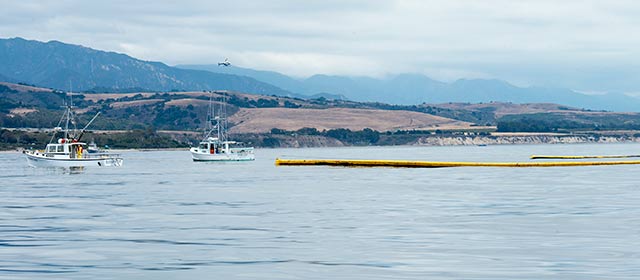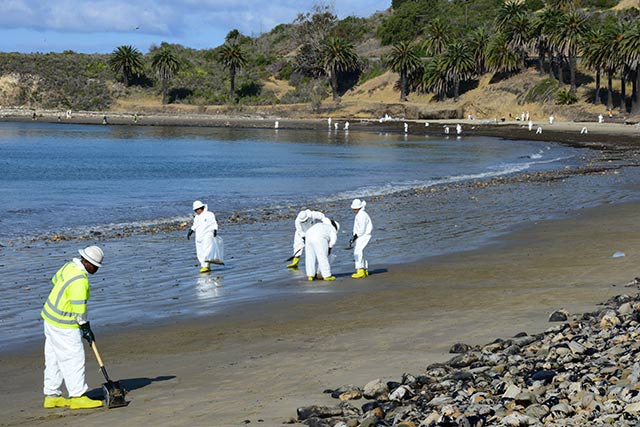
Honest, paywall-free news is rare. Please support our boldly independent journalism with a donation of any size.
On the night of March 23, 1989, the Exxon Valdez left the Alyeska Pipeline Terminal, carrying more than 1.2 million barrels of crude oil from Alaska’s North Slope. Three hours into its journey to Long Beach, California, the Valdez grounded at Bligh Reef, in Prince William Sound, rupturing eight of its 11 cargo tanks and spilling some 10.8 million gallons of crude oil.
In the wake of the spill, which still reigns as one of the largest in U.S. history, the American government established the Oil Pollution Act of 1990. The legislation consolidated existing federal oil spill laws and created new requirements for prevention and response. Pacific Northwest states began creating programs to protect coastlines. Pretty soon, the number of marine vessels spilling their slippery black cargo into America’s waters declined. But now, in 2015, oil is increasingly transported by rail, not ships, and Western states are in a vulnerable position, should oil spills occur.
The oil spill response and prevention programs that originally sprung up around marine tanker traffic are struggling to keep pace with the shift in transportation. As more oil is transported via rail and pipeline, the coastal contingency plans and funding models have lost relevance. Regional contingency plans are now needed inland, though none exist at the state level and few at the federal level. This has left the river systems and inland areas of coastal states exposed, says David Byers, response manager for Washington’s Spill Prevention, Preparedness and Response Program.
“We’re seeing a lot more of the Bakken crude coming through the rail lines into Washington, Oregon and California,” says Sarah Brace, executive coordinator of The Pacific States – British Columbia’s Oil Spill Task Force. In Washington, where in recent history 90 percent of crude oil was delivered by vessels, that number fell to 59 percent in 2014. Rail brings in 24 percent and pipelines account for another 17. In California, the percentage of crude oil imported via rail to California refineries jumped by 506 percent between 2012 and 2013.
Over the past year and a half, Washington, Oregon and California have increased funding for their oil spill prevention and response programs. In 2014, the California legislature approved the expansion of a 6.5 cent per barrel tax to include crude oil and petroleum products transported by railways and pipelines in the state; the resulting funds will be available for inland emergencies instead of just for the coast. And last week, a new requirement in California for inland railways to establish oil spill contingency plans went into effect.
Similarly, in April, Washington passed a law to apply their 4 cent per barrel oil spill prevention tax and 1 cent oil spill response tax to crude oil or petroleum products received at a bulk oil terminal from a tank car. The new law also gives the state the authority to regulate private rail companies’ spill response and prevention efforts.
Oregon hasn’t yet sought inland regulations or surcharges, as the state doesn’t have refineries. Instead, this spring, Oregon’s Senate Bill 262 increased the state’s taxes on marine vessels and port transfer facilities by nearly 50 percent in some cases to make up for dwindling reserves in the state’s $800,000 pot that pays for response and prevention personnel.
When California announced plans to regulate rail companies’ preparedness for oil spills, two rail companies promptly sued, arguing states didn’t have the authority. The court later threw out the lawsuit until California had established clear regulations. Part of what companies are worried about is inconsistency in requirements from state to state.
“There should be some uniformity of the laws [rail] has to comply with. If every little city and county had a different set of rules for a train or a pipeline as it moved across the country, they could have an impossible hodgepodge to comply with,” says Ryan Todd, attorney for California’s Office of Spill Prevention and Response.
But on the other hand, Todd adds, under the federal Clean Water Act, states should have the authority to regulate oil spill response and prevention.
At the federal level, the Pipeline and Hazardous Materials Safety Administration is seeking comment on how to adjust their oil response plans to apply to rail. Currently, rail companies are subject only to basic requirements. Comprehensive response plans are required only when more than 42,000 gallons of oil per tank car are transported. But large tank cars of this size aren’t used to transport oil. Thus, the National Transportation Safety Board has recommended PHMSA reconsider the threshold quantity.
The new push toward better prevention and response programs is motivated not only by an increase in railway transport, but a recent uptick in spills. More crude oil by volume was spilled in rail accidents in 2013 than in the previous 40 years combined. And in 2014, trains spilled crude oil more often than in any other year, averaging 25 spills each day.
“If there’s a big spill to Puget Sound, it’s going to impact and possibly even shut down ports,” says David Byers. He cites a 2006 study where officials learned if a major spill occurred in Puget Sound, it would cost the state $10.8 billion in economic impact and more than 165,000 jobs would be lost. The state’s emergency response fund, even when topped up, is a mere $9 million.
“That’s about 20 minutes of Deepwater Horizon,” Byers notes with a touch of humor. In 1991, when the fund was established, that reserve was capped at $25 million, and has been chipped away since. But Byers questions whether $25 million would even be enough for today’s cleanup costs.
In California alone, rail lines pass over inland waters in 7,000 locations. Along the Washington side of the Columbia River, rail lines transporting crude run parallel to and near the river. In most cases, says Mike Zollitsch, the emergency response coordinator for Oregon, waterways carve an excellent path for railways, which means many rivers have railroads nearby.
 Beach cleanup crew members work to cleanup oil from the beach at Refugio State Beach, California. (Photo: Chief Petty Officer David Mosley / US Coast Guard)
Beach cleanup crew members work to cleanup oil from the beach at Refugio State Beach, California. (Photo: Chief Petty Officer David Mosley / US Coast Guard)
Though oil companies contribute to the federal multimillion-dollar Oil Spill Liability Trust Fund via a per barrel tax, accessing that money can be laborious. The advantage of state funds is they can be tapped more quickly to respond to an immediate spill. Instead of waiting to identify a liable party or chasing after reimbursement, states can get to work right away, in order to beat spills to the shoreline.
Another downside of the federal liability fund is that states aren’t always fully reimbursed for what they spend on a spill or prevention. Companies are required to show they have enough money to finance a cleanup, should a spill occur. But those requirements don’t always cover the cost of a catastrophic event. In Oregon, companies need only show $10 million in reserve, while Alaskan crude oil tank vessel operators are responsible for $112 million, and California companies must show $1 billion.
Plus, some states, like Washington, have higher standards for cleanup in the case of a coastal oil spill, Byers says.
Unlike coastal states, where small but active prevention and response funds exist, Montana and Wyoming have no strict state spill and prevention funds at all. When the Poplar Pipeline ruptured on January 17, 2015, spilling 30,000 gallons of crude oil into Montana’s Yellowstone River, it wasn’t until January 20 that 240 barrels of crude oil were recovered from the water. Efforts were funded by the governor’s environmental contingency plan, which never holds more than $750,000. Currently, specific oil spill response programs aren’t under consideration.
The State of Alaska still relies on vessels and pipelines for oil transport, charging a 5 cent prevention and response surcharge on each barrel of oil produced. But declines in production on the North Slope have contributed to a $6 million deficit in the state’s $12 million prevention account, says Kristin Ryan, director of Alaska’s Division of Spill Prevention and Response. The response account has held steady at $50 million.
This past spring the Alaska legislature narrowly passed a one-cent per gallon tax on refined fuel used by consumers to make up for the shortfall – their first new tax in nearly a decade.
Back in Washington, where Shell’s Arctic fleet now docks, Byers ponders the future of oil spill response. “We have a lot more work to do. The risk is in areas of the state where it’s never been before – areas of the state that aren’t prepared for a major spill. That’s our challenge right now; as the energy picture shifts in the state, so does the risk picture.”
Media that fights fascism
Truthout is funded almost entirely by readers — that’s why we can speak truth to power and cut against the mainstream narrative. But independent journalists at Truthout face mounting political repression under Trump.
We rely on your support to survive McCarthyist censorship. Please make a tax-deductible one-time or monthly donation.